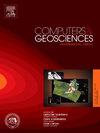Controlled latent diffusion models for 3D porous media reconstruction
IF 4.4
2区 地球科学
Q1 COMPUTER SCIENCE, INTERDISCIPLINARY APPLICATIONS
引用次数: 0
Abstract
Three-dimensional digital reconstruction of porous media presents a fundamental challenge in geosciences, requiring simultaneous resolution of fine-scale pore structures while capturing representative elementary volumes. This work introduces a computational framework that addresses this challenge through latent diffusion models operating within the Elucidated Diffusion Models (EDM) framework. The proposed approach reduces dimensionality via a custom Variational Autoencoder trained in binary geological volumes, improving efficiency and also enabling the generation of larger volumes than previously possible with diffusion models. A key innovation is the controlled unconditional sampling methodology, which enhances distribution coverage by first sampling target statistics from their empirical distributions, and then generating samples conditioned on these values. Extensive testing on four distinct rock types demonstrates that conditioning on porosity – a readily computable statistic – is sufficient to ensure a consistent representation of multiple complex properties, including permeability, two-point correlation functions, and pore size distributions. The framework achieves better generation quality than pixel-space diffusion while enabling significantly larger volume reconstruction ( voxels) with substantially reduced computational requirements, establishing a new state-of-the-art for digital rock physics applications.
三维多孔介质重建的可控潜扩散模型
多孔介质的三维数字重建是地球科学领域的一个基本挑战,它需要在捕获代表性基本体积的同时,对细尺度孔隙结构进行分辨率处理。这项工作引入了一个计算框架,通过在阐明扩散模型(EDM)框架内运行的潜在扩散模型来解决这一挑战。该方法通过自定义的变分自编码器(Variational Autoencoder)减少了二进制地质体积的维数,提高了效率,并且能够生成比以前使用扩散模型更大的体积。一个关键的创新是受控无条件抽样方法,它通过首先从其经验分布中抽样目标统计量,然后根据这些值生成样本来增强分布覆盖率。对四种不同岩石类型的广泛测试表明,孔隙度(一个易于计算的统计数据)的调节足以确保多种复杂属性的一致表示,包括渗透率、两点相关函数和孔隙大小分布。该框架实现了比像素空间扩散更好的生成质量,同时实现了更大的体积重建(2563体素),大大减少了计算需求,为数字岩石物理应用建立了新的技术水平。
本文章由计算机程序翻译,如有差异,请以英文原文为准。
求助全文
约1分钟内获得全文
求助全文
来源期刊

Computers & Geosciences
地学-地球科学综合
CiteScore
9.30
自引率
6.80%
发文量
164
审稿时长
3.4 months
期刊介绍:
Computers & Geosciences publishes high impact, original research at the interface between Computer Sciences and Geosciences. Publications should apply modern computer science paradigms, whether computational or informatics-based, to address problems in the geosciences.
 求助内容:
求助内容: 应助结果提醒方式:
应助结果提醒方式:


